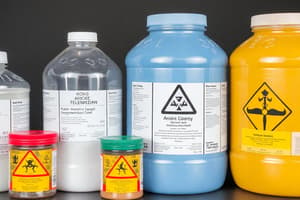Podcast
Questions and Answers
Which of the following is NOT considered a hazardous material category?
Which of the following is NOT considered a hazardous material category?
- Flammable/combustible materials
- Radioactive materials (correct)
- Toxic materials
- Aerosol containers
What is the Navy's policy regarding hazardous waste on ships?
What is the Navy's policy regarding hazardous waste on ships?
- Ships are responsible for transporting hazardous waste to shore facilities.
- Ships should minimize hazardous waste generation but it is unavoidable.
- Ships should strive to completely eliminate hazardous waste generation. (correct)
- Ships are allowed to generate hazardous waste as long as it is properly disposed of.
What is an example of incompatible materials mentioned in the text?
What is an example of incompatible materials mentioned in the text?
- Compressed gases and flammable liquids
- Acids and bases
- Oil-based products and Liquid Oxygen (LOX) (correct)
- Paint and water
What is the first step to take when a hazardous material spill is discovered?
What is the first step to take when a hazardous material spill is discovered?
What information is NOT required to be reported when a hazardous material spill is discovered?
What information is NOT required to be reported when a hazardous material spill is discovered?
Which of the following is NOT considered personal protective equipment required when handling hazardous materials?
Which of the following is NOT considered personal protective equipment required when handling hazardous materials?
What is the definition of hazardous waste?
What is the definition of hazardous waste?
Why is it important to minimize the generation of hazardous waste on ships?
Why is it important to minimize the generation of hazardous waste on ships?
Flashcards
Hazardous Material (HM)
Hazardous Material (HM)
Any material that poses a hazard to health or environment due to its characteristics or usage.
Hazardous Waste (HW)
Hazardous Waste (HW)
Discarded material classified as HM or designated hazardous by authorities.
Six Categories of HM
Six Categories of HM
Flammable, Aerosol, Toxic, Corrosive, Oxidizing, Compressed gases.
Incompatible Material
Incompatible Material
Signup and view all the flashcards
HM/HW Spill Reporting
HM/HW Spill Reporting
Signup and view all the flashcards
Initial Spill Response Information
Initial Spill Response Information
Signup and view all the flashcards
Personal Protection Equipment (PPE)
Personal Protection Equipment (PPE)
Signup and view all the flashcards
Environmental Protection Agency (EPA)
Environmental Protection Agency (EPA)
Signup and view all the flashcards
Study Notes
Hazardous Materials (HM) and Hazardous Waste (HW)
- Hazardous Material (HM): Any material that, due to its quantity, concentration, or properties, poses a substantial risk to human health or the environment if mishandled, released intentionally, or spilled accidentally.
- Hazardous Waste (HW): Any discarded material (solid, liquid, or gas) that meets the HM definition or is designated as hazardous waste by the Environmental Protection Agency (EPA) or a state authority. Ship policy is that ships do not generate HW.
Categories of Hazardous Materials
- Flammable/Combustible Materials
- Aerosol Containers
- Toxic Materials
- Corrosive Materials (acids and bases)
- Oxidizing Materials
- Compressed Gases
Incompatible Materials
- Certain materials, typically safe individually, can become hazardous when in contact or close proximity.
- Example: Oil-based products and Liquid Oxygen (LOX); Chemical conversion coatings and acids or combustibles (like paint, naphtha). HM in excess of a ship's needs.
HM/HW Spill Procedures
- Discovery: Spills or potential spills may be found through routine inspections, detection devices (fire alarms, oxygen deficiency detectors), or normal operations.
- Immediate Reporting: Any HM/HW spill or potential spill must be immediately reported verbally to supervisors and the Officer of the Deck (OOD) /Command Duty Officer (CDO).
- Crew Restrictions: Crewmembers should not investigate the spill.
- Reporting Information (if possible):
- Time of discovery
- Location
- Spilled material's identity
- Material's behavior (reactions observed)
- Spill source (container, tank)
- Personnel near the spill (names, departments)
- Spill volume
- Anticipated movement (e.g., from midship to galley)
- Labeling/placarding information (from the container only after exposure is eliminated)
Personal Protective Equipment (PPE) for HM/HW Handling
- Eye Protection
- Respiratory Devices
- Gloves
- Apron
- Coveralls
- Rubber Boots
Underway and Import Discharge Limitations
- Trash/Garbage (non-plastics): Pulped/comminuted (3-25) direct discharge permitted, exceeding 25 unsuitable for direct discharge.
- Plastic: No discharge permitted.
- Sewage: Discharge beyond 3 nautical miles.
- Oily Waste: Discharge beyond 12 nautical miles if equipped with an Oil Content Monitor (OCM) <15ppm oil, or 50 nautical miles if equipped with an Oil Water Separator (OWS) and no OCM.
- Paint/Mineral Spirits: No discharge permitted.
Studying That Suits You
Use AI to generate personalized quizzes and flashcards to suit your learning preferences.




